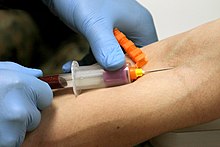Laboratory applications In the laboratory, EDTA is widely used for scavenging metal ions In biochemistry and molecular biology, ion depletion is commonly used to deactivate metaldependent enzymes, either as an assay for their reactivity or to suppress damage to DNA, proteins, and polysaccharides1 full 6 mL pinktop (EDTA) tube with label that includes patient's first and last name, PF#/MR#, time, date, printed last name of phlebotomist Send specimen and order form to Blood Bank immediately STAT (urgent) request – if type specific units are on hand in the Blood Bank, crossmatched blood will be available on 1 hour noticeContamination of blood specimens with potassium EDTA is a major problem for the Clinical Biochemistry department What are the effects of EDTA contamination?

Best Practices In Capillary Blood Collection Medical Laboratory Observer
Edta blood sample used for
Edta blood sample used for-Increased potassium leading to an invalid interpretation of potassium status Decreased calcium, magnesium and alkaline phosphatase So why use potassium EDTA if it is such a problem? The TSC blood collection tube contained 38% of TSC and that of EDTA contained 80 mg of EDTA in it Then 16 ml of the whole blood sample was added to the 04 ml of 38% TSC solution, and 30 ml of blood was added to EDTA tube and immediately mixed by inverting the tubes three times Then ESR values were measured by the Westergren method




Vacutainer Edta Tube With Hemogard Closure Pink Dufort Et Lavigne
The use of EDTA for measuring cytokines, protein and peptides, and cardiac markers is described, with an outline of the protection of labile molecules provided by this anticoagulant The use of EDTA in proteomics and in general clinical chemistry is also described in comparison with other anticoagulants and with serum samplesEDTA, a blood preservative, was identified on stains prepared from the K67 and K68 blood samples from Nicole Simpson and Orenthal J Simpson, respectively No EDTA was identified in the blood stains removed from the Q4 swabbing of theIf commercially available tubes are to be used, the researcher should use the red topped tubes These are available from Becton Dickinson (BD) BD's trade name for the blood handling tubes is Vacutainer After collection of the whole blood, allow the blood to clot by leaving it undisturbed at room temperature This usually takes 15–30 minutes
An added precaution is to never use iodine or Betadine solutions to cleanse the skin before collecting blood samples to prevent possible interference of test results, especially in the analysis of potassium, glucose, and total protein edta , flouride aslo we usedSee edetate Called also edetic acid MillerKeane Encyclopedia and Dictionary of Medicine, Nursing, and Allied Health, SeventhUsed as an anticoagulant for preserving blood specimens Also used medicinally;
Types/ Forms of EDTA Routinely used are I Tri potassium saltsEDTA (K3 EDTA) II Di sodium EDTA (Na2 EDTA) Mode of Action • It forms insoluble calcium salts by chelation Concentration • 05 – mg EDTA per/ ml of blood will preserve blood excellently for at least 6 hrs EDTA is compatible with downstream RTPCR applications (unlike sodium heparin which can inhibit RT enzymes) Available in multiple sizes depending on how much blood is needed (2, 3, 4, 6, and 10 mL options) Provides the most options for processing RBC lysis, buffy coat isolation, and Ficoll gradient separationOccurring in blood samples;



Vacutainer Tubes And Their Uses Pathology Made Simple




Best Practices In Capillary Blood Collection Medical Laboratory Observer
Ethylenediaminetetraacetic acid (EDTA) eth″ĭlēndi″ahmēntet″rahahse´tik a chelating agent that binds calcium and other metals; Indications for the whole blood, plasma, and serum A whole blood sample is used for blood gases and ammonia It may be used for glucose, urea nitrogen, and lactate estimation Serum and plasma are used for the majority of the chemical tests The disadvantage of plasma is that if you store the sample, there are chances to form fibrin clotsThe CBC is performed on the Coulter® DxH 800 analyzer using the SP's EDTA blood tubes which are obtained via the phlebotomy component I Purpose and Principle of Test whole blood CBC and body fluid In sample dispensing, whole blood sample segments are dispensed via the aspiration probe into the mixing chambers on the Air Mix Temperature




Vacutube Evacuated Blood Collection Tube




Sample Collection Overview Diagram Outlining The Sites Of Blood Sample Download Scientific Diagram
This is your basic hematology tube (by which I mean identifying and counting blood cells, blood typing, etc) Plasma stored from EDTAtreated blood can also be used to measure most proteins, and genetic material can easily be stored from EDTA buffy coats (the interface between the red cells and the plasma after centrifugation, containing white cells and platelets)EDTA acts on whole blood by chelating divalent cations such as calcium and magnesium EDTA can be found as a salt complexed to either potassium (K 2 or K 3) or sodium (Na 2) It is most commonly used when the blood sample will undergo hematological testsPlease do not use blood pressure cuff) • 21 gauge Butterfly needles with luer adapter (BD #7251) • Vacutainer barrels • Timer/stopwatch




China Medical Disposable Purple Cap Vacuum Blood Collection Pet Glass Edta K2 K3 Tube China Vacuum Blood



Long Term Storage Impacts Blood Dna Yield But Not Integrity Or Methylation
A Yes, the BD Vacutainer K2EDTA Plus Tubes are intended for routine immunohematology testing, including red cell grouping, Rh typing and antibody screening Purple blood bottles contain EDTA (ethylenediaminetetraacetic acid), which acts as a potent anticoagulant by binding to calcium in the blood EDTA also binds metal ions in the blood and is used in chelation therapy to treat iron, lead or mercury poisoning EDTA is used to lower blood levels of calcium when they have become dangerously high 34 Related Question Answers Found (EDTA) is a sample tube anticoagulant used for many laboratory analyses Gross potassium EDTA contamination of blood samples is easily recognised by marked hyperkalaemia and hypocalcaemia




Greiner Bio One Vacuette K Sub 3 Sub Edta Blood Collection Tubes Fisher Scientific




Edta Uses Reagent Prepration And More Lab Tests Guide
It chelates to ions in blood to prevent clotting If present in a blood evidence sample, it could be indicative that the blood sample may have been planted at the crime scene to implicate a suspect EDTA is also reported to modify clothing and exist in detergents, to allow dyes to set and prevent rancidity in soaps In an EDTA sample, blood cells preserve their cell morphology well (or the changes in morphology are known and do not cause diagnostic confusion), and there are minimal nonphysiologic effects on the cells When tubes with solid EDTA are used, there is no dilution of the sample In this study, tubes were used in which EDTA was in liquid formOr observed that after 24 hours, blood samples anticoagulated with EDTA degenerate more than other types of anticoagulated blood samples7 Only a few controlled studies compared the hematologic values of avian blood samples collected in heparin and EDTA1,8–10 In a study that evaluated pigeon blood, the temporal effect




Vacutainer Wikipedia




Blood Sample Collection Tubes Top Colors And Anticoagulants Mode Of Action Youtube



0 件のコメント:
コメントを投稿